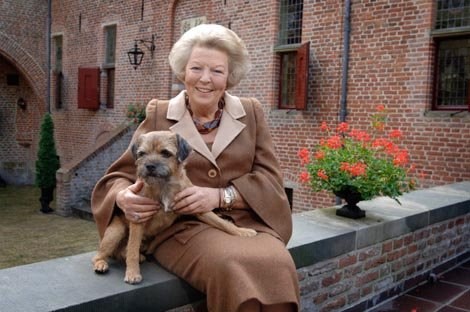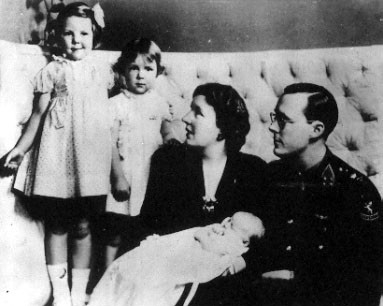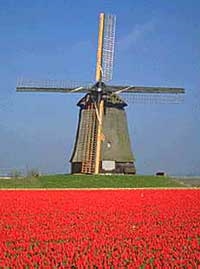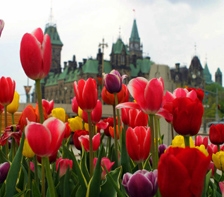 |
| Her Majesty Queen Beatrix with her dog Chip. (RVD/photo Raymond Rutting) |
Every spring, Ottawa, the Capital of Canada, explodes with the color of millions of tulips in full bloom. They start near the parliament buildings and spread out from there… along Rideau canal and through the parks and streets. This amazing display had its beginnings just after the end of World War 2. In 1945, the Dutch Royal Family and the people of the Netherlands donated 120,000 tulip bulbs in gratitude for the part Canadian troops played in the liberation of Holland. This gratitude extended to the safe haven Canada provided to Princess Juliana and her daughters, including the present Queen of the Netherlands…Her Majesty Queen Beatrix. Canadians and the people of Holland have shared a strong bond ever since. It is reinforced each year in early May, when a vast array of tulips with names like Orange Princess, Angelique, Dreaming Maid and Fringed Elegance appear in Ottawa, 3 million strong.
 |
| Princess Juliana in Ottawa with her 3 daughters. (Government of Canada) |
Her Majesty Queen Beatrix of the Netherlands was only two years old when she and her family were forced to flee from their homeland during World War 2. The year was 1940 and the Nazis had just invaded Holland and were looking to capture and assassinate the Dutch Royal Family. Beatrix's mother, Princess Juliana, and father, Prince Bernhard, escaped to the United Kingdom along with their children, the Princesses Beatrix and Irene, and Queen Wilhelmina. But their safe haven was short-lived. Because of the heavy bombing taking place in England, Princess Juliana secretly boarded a Dutch ship and fled to Canada with her two young daughters. They were welcomed at Stornaway, the official residence of the Leader of the Opposition Party in Canada. This house would serve as their home-in-exile while the war raged in Holland. It was a terrible time in Holland that saw thousands of civilians, Jews, resistance fighters and members of the Dutch military arrested, killed, tortured and sent to concentration camps. After years of occupation by Germany, many in Holland were left to starve and were reduced to, among other things, digging up tulip bulbs to eat.
 |
| Tulip field in the Netherlands. (www.growingtulips.com) |
In Canada, Princess Beatrix and her sister, Princess Irene, attended nursery and primary school at Rockcliffe Park Public School along with the children of politicians and ambassadors. Shielded from the horrors she had left behind, the future Queen was able to enjoy a relatively normal childhood. In her new Canadian home there would be skiing (water and snow), sledding, horseback riding, swimming and sailing. Other famous alumni of Rockcliffe include the children of Prime Minister Trudeau, current Prime Minister Stephen Harper and actor Matthew Perry. Princess Juliana did what many war wives of the time did: she helped with the war effort by knitting for the soldiers, raised money by working in a second-hand store and did whatever she could to keep up the morale of her people. She also acted as her mother's representative and her people's ambassador, travelling in Canada, the United States and the Netherlands Antilles, visiting military troops and generating support for the effort to win the war. On January 19, 1943, Princess Juliana, heir to the Dutch Throne, gave birth to a third daughter, Princess Margriet at the Ottawa Civic Hospital. The Canadian Government proclaimed the hospital's maternity suite "extraterritorial" so that the baby would be born on Dutch territory and have full Dutch citizenship. The baby's name meant "daisy", a flower chosen by Queen Wilhelmina as a symbol of resistance and hope in the Netherlands. This was the first royal baby ever to be born in North America. (Copy and paste the following URL into your web browser to see archival footage from the Canadian Broadcast Corporation of this historical event.
 |
| Canadian Troops Liberating Holland |
According to Canadian Governmental Archives, by April 28, 1945, "German military leaders knew that the end was near. A truce was negotiated and food began to reach the starving civilian population (of Holland). General Johannes Blaskowitz, commander of the occupation forces, surrendered to Lieutenant-General Foulkes of the 1st. Canadian Army Corps on May 5, 1945. The war in the Netherlands was finally over. After five years in hiding, the red, white and blue national flag reappeared in the towns and villages, as did the orange banners of the House of Orange representing the Dutch Royal Family. By the thousands, Canadian soldiers laid down their arms and began to rebuild houses, dikes and bridges. Canadian military physicians attended to civilians and many troops provided help to the population so cruelly affected by the war. Seven thousand Canadian soldiers had died in the campaign to liberate the Netherlands and the Dutch were eager to show their gratitude. Children gathered wildflowers to place on the graves of the fallen soldiers. Romance bloomed amid the aftermath of war and lasting bonds were formed between Canadians and the Dutch people. Many of these romances ended in marriage. The Canadian Government paid the passage to Canada for more than 1,800 Dutch war brides and some 400 children."
 |
| Tulips blooming on Parliament Hill in Ottawa. (canadacool.com) |
The Dutch Royal family was re-united in their homeland in the late summer of 1945. Many magnificent gifts were given to Canada and her people by the grateful citizens of Holland and its Royal Family, but none so lasting and spectacular as the tulips. The National Capital Commission, part of the Canadian Government, oversees the planting and maintenance of what has now reached close to 3 million tulips that have been gifted over the past 50 years. This symbol of international friendship between Canada and the Netherlands will live on and delight many generations to come…but also remind us all of the terrible price of war.
Queen Beatrix has taken over the tradition of the tulips to honor the memory of her mother Queen Juliana, who died in 2004 at the age of 94 years. The best time to see the tulips blooming in Ottawa and in the Netherlands is the beginning of May when spring is in full bloom.
Page created on 9/29/2012 9:40:33 PM
Last edited 1/9/2017 10:01:21 PM
Info Courtesy of www.growingtulips.com
The history of the tulip, and how to grow and care for one properly.
The tulip is a beautiful flower, and also a cheerful reminder of Spring. Read this article to learn the history, nature and cultivation of the tulip.
The tulip is also known by the Latin name tulipa. It requires partial to full sun to flourish, and for this reason often survives an average of three days indoors. It is planted at a depth of 8 to 9 inches under the soil, and the tulip is often planted in the fall for spring blooms.
The tulip is actually a native of central Asia! The tulip is a native of the Tien-Shan and Pamir-alai Mountain Ranges near Islamabad. Tulips spread to China and Mongolia from this point, and from there entered the far reaches of Europe. The Turkish Empire is greatly renowned for having the tulips that now decorate the Netherlands, and the Turks were known as cultivators of this flower through Persia and Asia from as early as 1,000 A.D.
Tulips are greatly associated with the Dutch, and this is because of a famous Dutch gardener named Carolus Clusius who was born in 1593. Clusius was the head gardener at the University of Lieden in Holland, where his work in botany, herbs and medicine was well-known. He was the first to plant tulips in what has today become a land renowned for its fields of tulips and daffodils. His work in this area was remarkable, for the tulip is considered a wild flower due to its origins in mountainous terrain and varieties. Certain kinds of tulips grow under rocks and only in the highest climates.
When planting tulips, it is nice to place them close to one another to avoid having them standing by themselves in the Spring. This is one flower that always looks better in groups. You can place bulbs as close as six inches away from each other in the ground, and for long rows of tulips, sometimes it is nice to dig a trench to plant them in. Tulips require ground that does not retain much water, because with prolonged exposure to water in the ground they tend to rot. You can test the ground by pouring water in a hole and checking to make sure it drains away in a reasonable amount of time.
When tulips begin to die in the summer, its important to leave them until they have all become brown. This ripens the soil for the next year, and also allows the tulips to live to their full life span. Be sure to rake away the browned and dead parts of tulips in June or July, however.
